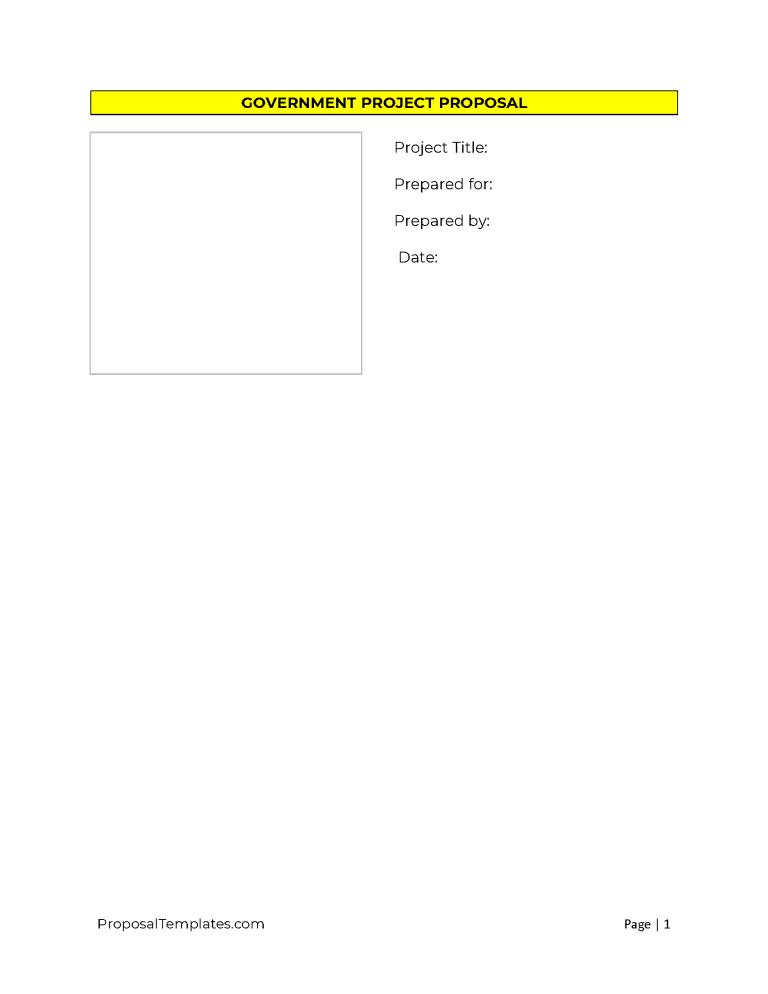Government project proposals are generally written to answer RFPs or to apply for a government-funded project. The proposal must often adhere to government guidelines; however, the majority will always cover several key project points (i.e., budget).
Types Of Government Project Proposals (9)
- Budget Proposals – A pitch written to gain government projects with strict budget requirements therefore concentrating on expense breakdowns and project efficiency.
- Feasibility Study – A proposal to evaluate a government project’s likelihood of completion (i.e., infrastructure projects) and focuses on methodologies and track records.
- Government Grant – A proposal written to attract government funding for a specific project; thus, definitive funding gaps and projected outcomes are discussed.
- Policy Proposals – A pitch to seek government projects that evaluate government policies (i.e., environmental policies), featuring analytic methods and research techniques.
- Program Evaluation – A proposal seeking to evaluate government programs, thus promoting the investigator’s evaluation techniques and reporting procedures.
- Public-Private Partnership (PPP) – A government invitation to private entities generally inviting partnerships for specific project goals.
- Research Proposals – A bid seeking government funding for specific research projects such as in social sciences and details methods and budgeting.
- RFP (Request for Proposal) Responses – A request for proposals issued by government agencies whenever a project becomes an available contract.
- Technical Proposals – Proposals detailing the technology requirements of a government project and must satisfy high-tech demands such as IT system implementation needs.
What Should Be Included (12 Items) |
1. Government Project Proposal Cover Page
Create a cover page that delivers an eye-catching first impression of the organization in addition to conveying information. Include the title and involved parties as well as promotional elements.
- Project Name, Proposal Title, Subtitle
Proposing Company Name, Proposing Company Logo
Submission Date, Contact Point
Government Agency Name, Department Name
Promotional Graphics, RFP Compliance
2. Government Project Proposal Executive Summary
Display a comprehensive description of the proposal’s contents; however, keep it concise and engaging. Explicitly promote the organization’s strategies and solutions when possible.
- Project Title, Purpose, Objectives, Collaborations
- Background, Scope of Work, Partnerships
- Timeline, Budget Summary, Key Personnel
- Methodology, Expected Outcomes
- Risk Assessment, Conclusion, Call To Action
3. Project Objectives
Discuss the interest and history of the organization behind this proposal while aligning its mission goals with the project’s objectives. Generally, keep this area professional, brief, and informative, as well as relevant.
- Title, Date, Proposing Organization, Needs Assessment
- Executive Summary Recap, Project Background
Problem Statement, Government Priorities, Initiatives
- Project Objectives, Policy Context, Target Audience
- Project Significance, Beneficiaries, Proposal Structure
4. Government Project Description
Place the project goals in perspective while presenting the significance of its outcome. Also, describe the work and resource requirements of the government project.
Project Goals, Scope, Objectives, Project Design
- Methodology, Target Population, Needs Assessment
- Timeline, Project Schedule, Project Components, Budget
- Collaborations, Partnerships, Resources, Project Activities
- Risk Management, Monitoring, Evaluation, Sustainability
5. Rationale
Further, discuss the justification for the project as well as its solution. For example, identify its beneficiaries, target audience, and stakeholders.
Background, Problem Introduction, Needs Assessment
Opportunity, Stakeholder Perspectives, Policy Compliance
Government Priorities, Potential Benefits, Risks
Evidence-Based Justifications, Social Impacts
Cost-Benefit Analysis, Service Gaps, Innovations
6. Methodology And Approach
Organize a detailed account of how the project will be completed, explicitly explaining the organization’s methods. Dispense the dates and times of the steps taken during the project.
- Research, Data Collection Methods, Sampling Strategy
- Instrumentation, Data Analysis Methods, Roles
- Project Components, Activities, Project Timeline
Data Collection, Analysis, Training, Capacity
Adaptability, Ethical Guidelines, Project Management
7. Budget
Document the project cost with an itemized list of each contributing expense while justifying each one. For example, present the costs of personnel, materials, and all other operational expenses.
Total Project Budget, Consultant Communication Costs
- Subcontracting, Indirect Costs (Overhead), Personnel
Equipment Costs, Materials, Travel, Accomodation
Supplies, Capacity Building, Budget Narrative
Funding Sources, Training, In-Kind Contributions
8. Qualifications And Experience
Formally identify each team member on the government project in addition to presenting their credentials and qualifications. Build the reader’s confidence in this team by exploring past individual achievements as well as team successes.
- Project Team, Resumes, Curriculum Vitae (CVs)
- Organizational Background, Relevant Projects, Experience
- Professional Certifications, Demonstrated Competencies
Capacity Building, Training, Innovation, Creativity
Success Track Record, Collaborations, Relevant Affiliations
9. Evaluation Criteria
Present assessment strategies to measure the project’s success during its lifetime, especially its final outcomes. For instance, specifically define its KPIs (key performance indicators).
- Request For Proposals (RFP) Compliance, Relevancies
- Project Design, Methodology, Formats, Presentation
- Sustainability Plan, Quality Assurance Measures
- Community Engagement, Participation
- Budget Justification, Cost-Effectiveness, Risk Management
10. Government Project Timeline
Specifically, call out milestone dates for the government project in addition to delivering a full calendar or timeline. For example, document its deadlines, deliverable dates, and meeting dates in a Gannt chart.
- Project Start Date, Duration, Activities, Milestones
- Personnel Assignments, Evaluations, External Facros
Dependency Relationships, Gantt Chart, Training Sessions
- Reporting, Engagement Events, Post-Project Actions
- Communication Schedule, Project Completion Date
11. Risk Management
Identify the challenges, risks, and obstacles attached to the government project as well as the strategies to overcome them. For instance, lay out contingency plans, precautions, and insurance policies to protect the project’s timeline and budget.
- Risk Prioritization, Risk Identification
Risk Assessment, Monitoring, Responsibility Assignment
Trigger Points, Communication Plan, Contingencies
Training, Awareness, Documentation, Precautions
Adaptability, Lessons Learned, Mitigation Strategies
12. Appendices
Consolidate all paperwork, charts, media, and supplementary information required but not thus far presented into appendices. Additionally, ensure this is an organized area by organizing this material in the order it is mentioned or composing an appendices table of contents.
Organizational Brochures, Resumes, Curriculum Vitae (CVs)
Supporting Research Data, Agreements, MOUs
Regulatory Compliance Documents, Training Materials
Accreditations, Research, Detailed Budget Breakdown
Project Designs, Visuals, Survey Instruments, Certification

